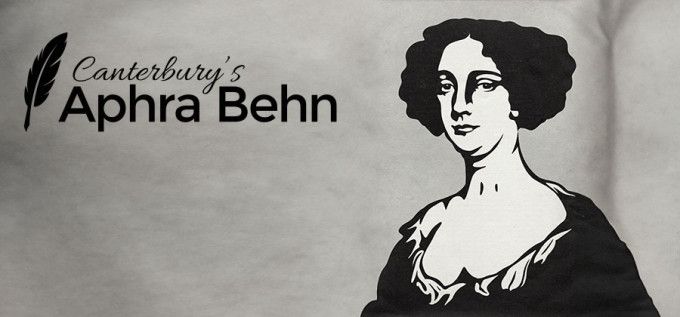Before I come to what has been happening this week, I thought I would start with a quick reminder about the Medieval Canterbury Weekend 2024 and to say that tickets sales are fine, but we would love to welcome even more people to hear our great speakers, including Janina Ramirez, Chris Woolgar, Louise Wilkinson, David Rundle, Caroline Barron, Marc Morris and many, many more! I appreciate regular readers are aware but for newcomers, please do check out our fantastic line-up using either: https://ckhh.org.uk/mcw or https://www.canterbury.ac.uk/medieval-canterbury and we will be delighted to see you between Friday 26 and Sunday 28 April inclusive.
I’m delighted to say there are only a couple of spaces left for the ‘Migrants, Merchants and Mariners in the Kentish Cinque Ports, c.1400-c.1600’ study day to be held on Saturday 23 March at the Dover Museum (community cinema), in conjunction with the Maison Dieu, which will be kindly hosted by Jon Iveson and Martin Crowther. This free event starts at 10am and finishes at 4pm comprising talks and our pop-up exhibition, for the final spaces: https://www.canterbury.ac.uk/arts-and-culture/event-details.aspx?instance=442606
The schedule in outline: 10am welcome, followed by Dr Craig Lambert on an Introduction to the Kent’s Maritime Communities, c.1400 to c.1600 project; me on Kent as a ‘Gateway County’. After a break, our final talk for the morning will be The Maison Dieu and the Sea by Kieron Hoyle. Lunch follows between noon and 1pm and there are several refreshment outlets nearby because Dover Museum is located in the Market Square, also useful for those seeking coffee etc during the morning and afternoon breaks. The afternoon opens with a talk by Jason Mazzocchi on The Free Fishermen and Dredgermen of Faversham, to be followed by Dr Robert Blackmore speaking on Maritime Trade and Kent’s Ports. We’ll then have a break before Dr Lambert again on Kent’s Ships and Mariners followed by our concluding Roundtable session. Moreover, we’ll be around all day and will be happy to discuss the pop-up exhibition with members of the audience.
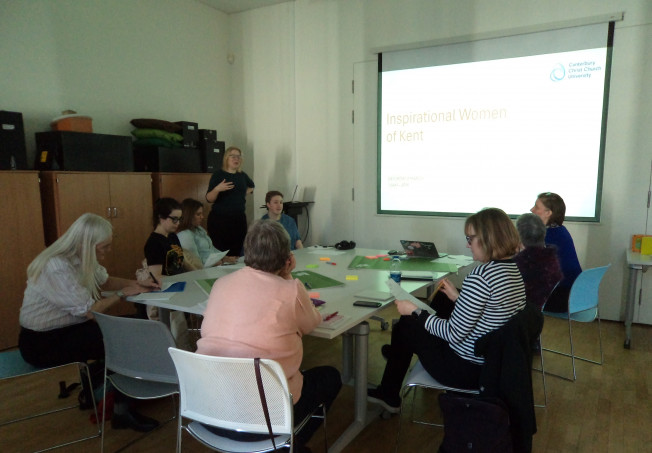
For upcoming events this week, I thought I would mention that the Centre for Anglican History and Theology, now also involving CCCU, and in conjunction with MEMS at Kent, will be holding a seminar on Thursday 14 March at 5pm in the Mabb Lovell Lecture Theatre, Old Sessions House. The speaker will be Professor Peter Marshall (University of Warwick) and his title is ‘Ecclesiastical History from the Edge: The Church in Early Modern Orkney’, all welcome.
Secondly, tomorrow (Wednesday 13 March), Dr Doreen Rosman will be giving the March CHAS lecture (following the AGM) at St Paul’s church, just outside Canterbury’s city wall, at c.7pm. Her title is ‘From Canterbury to America: Mayflower Pilgrims and other 17th-Century Emigrants’. Visitors are welcome and there is a £3 fee.
Now to events that have already taken place, I am going to keep this quite brief to ensure this goes up today because I have teaching and a meeting to factor in. Starting with last Saturday, it was great to be able to join Dr Catriona Cooper at The Learning Lab in the Beaney for the second of the CKHH events on Inspirational Women of Kent, which are linked to the AHRC-funded project on Aphra Behn and her works involving the universities of Loughborough, Kent and Canterbury Christ Church. This particular event had been designed to provide space for attendees to research and create biographies of inspirational Kent women, starting by mapping them across the county to explore the various clusters that started to develop very quickly. It was great to welcome participants from different constituencies – from postgraduates interested in digital resources, to members of the public who have been interested in collecting material on Kent’s women writers, politicians, collectors, folklorists and many more, as well as established academics, including Professor Elaine Hobby, the lead on the Aphra Behn project, and Helen Wright, who until recently was CCCU Humanities’ Impact Officer.
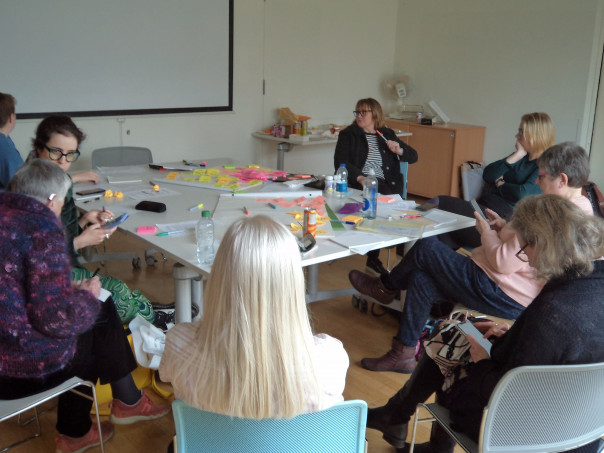
After the initial brain-storming session, the group went on a guided tour led by Cat to explore the Beaney’s holdings, especially its paintings and objects to see which are linked to or portray ‘inspirational Kent women’. For as well as ‘finding more women’, this tour offered ideas about artefacts that might be scanned in order to make 3-d models for the proposed virtual exhibition which it is hoped will be one of the outcomes from this project.
Having been inspired by what they had seen and discussed, the group set to work in the sessions either side of lunch to start populating the digital map by positioning the women across Kent and starting to produce short biographies which those visiting the platform will be able to access by clicking on the woman concerned. It was at this point, in the round-up session that I rejoined the group to see the results of their work. It was obvious from the various conversations that participants had enjoyed the day and had found it interesting and instructive. Dr Cooper will be setting this up soon and hopefully more women will be added to the map as time goes on – so many thanks for setting up this excellent event!
The final event I’m featuring briefly this week took place at the International Study Centre in the cathedral precincts on Monday (yesterday), which was a joint event organised by Canterbury Cathedral Archives & Library and MEMS at Kent with the Centre for Heritage. The study day marked the arrival at Canterbury Cathedral of Thomas Johnson’s ‘Quire of Canterbury Cathedral’ painted in 1657, which is currently housed in the cathedral archives but will be going on display in the cathedral itself.
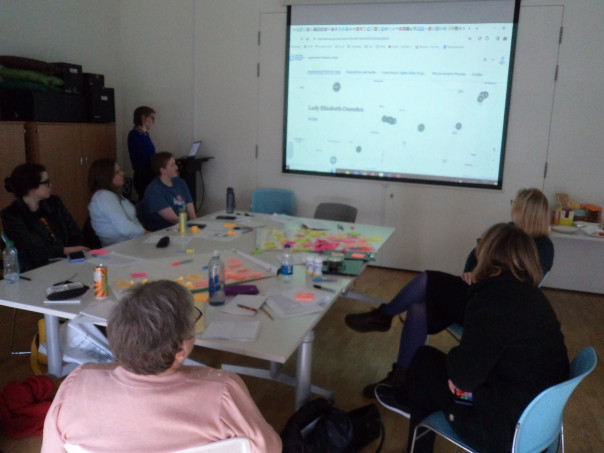
The first session of the day provided a very useful context for the later detailed considerations of the destruction in Canterbury Cathedral linked primarily to Becket and his cult. Thus, Professor Kenneth Fincham offered a fascinating summery of the religious changes that took place in the early 17th century, going on through the Civil War and Commonwealth period up to the Restoration. He carefully set out how and why Puritans responded as they did and the resulting iconoclasm across the country, including the various targets of what they saw as their righteous wrath in doing God’s work, including the Book of Sports – copies burnt by the public hangman where the Eleanor Cross (also destroyed by the Puritans) had previously stood. At Canterbury, one of the targets was the Laudian font, a representation of one of the two sacraments the Puritans viewed as dangerous in terms of Roman Christianity, the ‘new popery of Laud’ that they intended to stamp out, and now, from the early 1640s they were in a position to undertake.
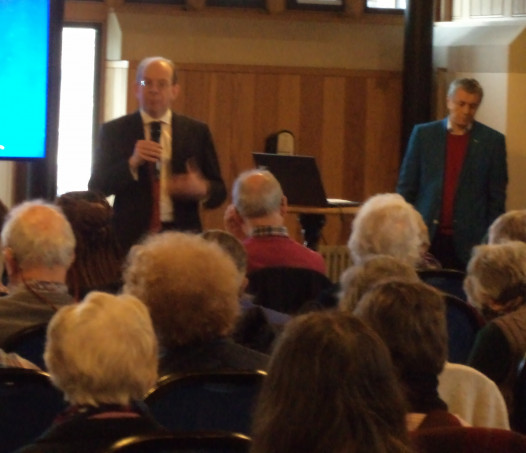
With the national context in place, the second presentation was also delivered by Ken Fincham because he read Professor Jackie Eales’ paper, sadly she was suffering from laryngitis, which covered Richard Culmer, the Civil War and iconoclasm in Canterbury Cathedral. Culmer is an interesting character, a hot-blooded Puritan minister who seems to have quarrelled with numerous people, albeit he did have some friends, but probably not among his parishioners! He was a published author in terms of such works as Cathedral News (1644), including reports on the ‘orderly destruction’ in the cathedral accomplished the previous December, and Lawles Tythe-Robbers Discovered (1654), which again shows his viewpoint forcibly. Culmer was one of the foremost iconoclasts, and he had allies among Canterbury’s civic authorities, including the mayor, aldermen and some citizens, while William Somner’s Antiquaries of Canterbury provided a guide from Culmer’s standpoint of what ‘needed’ to be destroyed. Not that stained glass was the only target and other parts of the cathedral and its environs that were damaged, destroyed or taken away were statues, tapestries, and books – for amongst other matters the Protectorate needed money. Nevertheless, the cathedral survived, albeit it took several years following the Restoration for it to return to something like its former state.
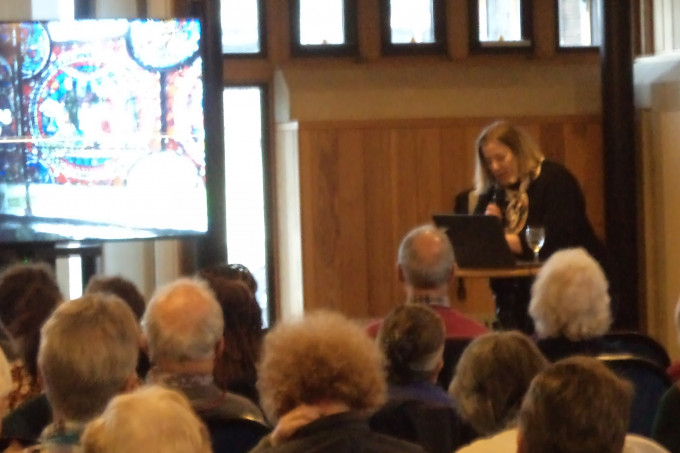
The lunch break offered a chance to view the painting and the first presentation thereafter was by Leonie Seliger in which she took a close look at Johnson’s painting to assess its accuracy. As she said she and Heather Newton had worked out the artist’s viewpoint and that he had employed perspective and what one might call the distortion needed from a wide-angle lens to take in everything east from the top of the pulpitum screen. Taking this as her starting point, Leonie then went round the painting looking at what can be seen in close-up of the stained glass windows in the clerestory and Trinity Chapel, both the glass and the ferramenta, especially their designs concerning the whole window and different sections within each. From this it was abundantly clear just how accurate the painting is, including little details such as a fragment of an ornamental border in one of the stained glass panels. Moreover, when viewing the east window of the clerestory, it would seem that Johnson was even recording a damaged section of the figure of Christ in Majesty ie it had already gone, and if anyone wants to know where the remains of this panel are now, they are not on display at the Virginia Museum of Art, Richmond, Virginia. He also appears to have painted part of the architecture of the Corona Chapel ie outside, as seen from inside which presumably meant he had a telescope.

This was an excellent presentation and set up the next presentation beautifully which was given by Dr Emily Guerry on the new evidence for the lost Gothic paintings of saints and kings in the vaults of the cathedral’s east end. To do this, Emily drew on the works of George Austin snr and jnr, who, as Cathedral Surveyors, had worked on the cathedral glass in the 19th century and had recorded much of what they had seen in considerable detail. Another who had seen traces of wall paintings now lost was the art historian E. W. Tristram. To this illustrious company Emily added Madeline Caviness, the great expert on stained glass, who had worked on this lost scheme of wall paintings in the early 1970s and had managed to identify some of these figures, and Emily thinks she has found another. Thus, we have saints that were universally popular such as St Peter, St Leonard, St Catherine of Alexandria and St Mary Magdalen, also St Blaise for whom there was a relic cult at Canterbury, similarly for three Canterbury archbishops: SS Dunstan, Alphage and Becket, who had eclipsed his predecessors, and interestingly Ethelbert as founder of the cathedral, almost at a position of crossover between saint and king, before three kings: Cnut, Edward the Confessor and Henry III. As an aside, I would be curious to know whether St Gregory, and even more St Augustine of Canterbury featured in this scheme. Emily also discussed what we know about the topographical arrangement of these paintings in the vaults, as well as other aspects relating to the use of red paint, thereby highlighting just how carefully this scheme had been constructed in its deployment of a cohesive hierarchy that was rooted in the special locality of Canterbury Cathedral.

The third presentation in this session was given by Dr David Rundle who took us figuratively outside the cathedral itself to the medieval priory’s book collection. As he said, Canterbury with its two ancient, great Benedictine houses was unravelled in terms of the number of books held there until the rise of Oxford University in the late Middle Ages. Yet perhaps of the priory’s over 2200 monastic books in the 1530s only 360 or about 16% are known to survive today. Such vagaries of survival are due to a number of reasons, but for Canterbury that only 26 are still in the cathedral library today is due in no small part to the activities of the Elizabethan Archbishops Parker and Whitgift, which means scholars are more likely to need to visit Cambridge and the colleges of Corpus Christi and Trinity if they want to view a Canterbury manuscript. For many of the rest, yes there are 56 in the British Library, but they arrived through a variety of means and most of the library presumably disappeared into the hands of small collectors never to be seen again. Furthermore, David was keen to highlight that the monastic priory’s library had been a living library – it grew and declined as the need arose, and books no longer viewed as necessary were at times dismantled to help restore others. It was interesting to see how this recycling had been done concerning the use of the margins to add unconnected accounts, for example, or the cutting back of margins, but not the text, to make book wrappers. This tradition became even more common in early 16th-century Canterbury, accelerated, was still happening in Mary’s reign and seems to have slowed before 1600. Thus, while there was destruction in the 16th century, it was of a different order and provides a fascinating contrast to the actions of those in the cathedral in the following century.
Unfortunately, I was unable to stay for the final session of Professor Rachel Koopmans, the expert on the Becket Miracle Windows, and Dr John Jenkins. However, I can report that Rachel in her presentation cleared up the matter of why the painting had been created. Johnson was intending to show Culmer as a judicious administrator carrying out the controlled removal of idolatrous artefacts. So ended a great conference that as well as celebrating the arrival of Johnson’s work, illustrated how valuable such material culture can be in our interrogation of the past.
 Centre for Kent History and Heritage
Centre for Kent History and Heritage Sheila Sweetinburgh
Sheila Sweetinburgh 1668
1668